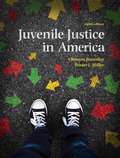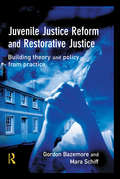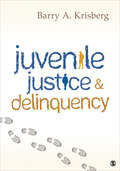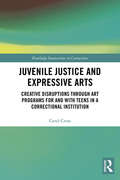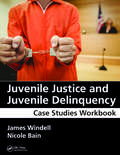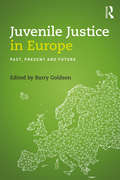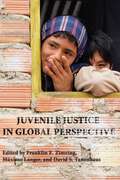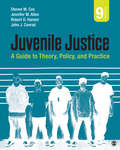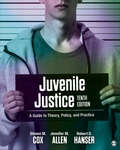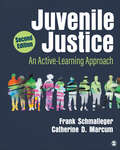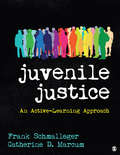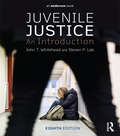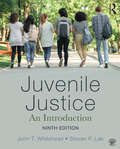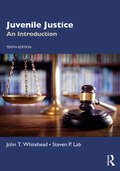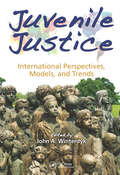- Table View
- List View
Juvenile Justice In America (Eighth Edition)
by Clemens Bartollas Stuart J. MillerJuvenile Justice in America provides an in-depth look at the lives of juveniles, their experiences in society, and the consequences of those experiences. The text carefully examines the structures, procedures, policies, and problems of American juvenile justice agencies. The Eighth Edition places further emphasis on delinquency prevention, and features a new chapter on juvenile offender populations to give readers a more comprehensive view of delinquents. Boxed features in every chapter highlight the practical realities of working in the juvenile justice system. The careful balance of theory, evidence-based findings, and practical applications gives readers the most up-to-date insight into the state of juvenile justice in America today.
Juvenile Justice Reform and Restorative Justice
by Gordon Bazemore Mara SchiffThis book, based on a large-scale research project funded by the National Institute of Justice and the Robert Wood Johnson Foundation, provides an overview of the restorative justice conferencing programs currently in operation in the United States, paying particular attention to the qualitative dimensions of this, based on interviews, focus groups and ethnographic observation. It provides an unrivalled view of restorative justice conferencing in practice, and what the people involved felt and thought about it. The book looks at four structural variations in the face-to-face form of restorative decision making: family group conferences, victim-offender mediation/dialogue, neighborhood accountability boards, peacemaking circles. The authors address two issues that have received limited research emphasis in restorative justice: the lack of clear and consistent standards, and the absence of testable theories of intervention that reflect what has become a rather diverse practice. In response the authors conclude with a proposed structure for principle-based evaluation designed to test emerging theories of restorative decision making.
Juvenile Justice and Delinquency
by Barry A. KrisbergJuvenile Justice and Delinquency brings into focus the causes of delinquency and provides students with a broad, up-to-date review of the latest research, statistical data, theories, and court decisions in the U.S. juvenile justice system. Author Barry Krisberg writes from a research-based approach which offers students pragmatic solutions to problems within the system—focusing on the reformative power of redemptive justice. Students will take away a foundational understanding of the current policies and issues shaping the juvenile justice system and practical strategies for helping juveniles improve and move their lives in a more positive direction.
Juvenile Justice and Delinquency
by Barry A. KrisbergJuvenile Justice and Delinquency brings into focus the causes of delinquency and provides students with a broad, up-to-date review of the latest research, statistical data, theories, and court decisions in the U.S. juvenile justice system. Author Barry Krisberg writes from a research-based approach which offers students pragmatic solutions to problems within the system—focusing on the reformative power of redemptive justice. Students will take away a foundational understanding of the current policies and issues shaping the juvenile justice system and practical strategies for helping juveniles improve and move their lives in a more positive direction.
Juvenile Justice and Expressive Arts: Creative Disruptions through Art Programs for and with Teens in a Correctional Institution (Routledge Innovations in Corrections)
by Carol CrossJuvenile Justice and Expressive Arts: Creative Disruptions through Art Programs for and with Teens in a Correctional Institution explores art programming as a sustainable educational initiative to support incarcerated teens’ successful reintegration to society. Responding to a lack of scholarly research on juvenile offenders and the role of art as education in correctional facilities, Carol Cross presents a qualitative study that examines critical pedagogy, adolescent development, and research into the governance and policies surrounding youth at a Canadian correctional facility. Through observational and interview data, action research, and visual analysis, the reader gains an insider's perspective into the lives of teens affected by crime and violence and the potential of art education to aid in increasing their self-esteem, social and emotional wellbeing, and personal development. Visual art and written stories created by male and female juvenile offenders are woven throughout the chapters to illustrate the use of creative expression as education and therapy. Suitable for scholars and researchers in juvenile justice and corrections as well as policymakers and practitioners in the field, this book will provoke dialogue on best practices for the rehabilitation and reintegration of institutionalized children and youth.
Juvenile Justice and Juvenile Delinquency: Case Studies Workbook
by James Windell Nicole BainDesigned as a supplemental text for juvenile delinquency and juvenile justice courses, this workbook fills a void in current textbooks. It provides a hands-on experience that helps students understand the kinds of court hearings that take place in juvenile and family courts. It presents information about actual cases and prompts students to make decisions and design court orders for typical juvenile court cases. It also provides a unique opportunity for students to experience what it is like to face decisions in the juvenile court system.
Juvenile Justice in Europe: Past, Present and Future
by Barry GoldsonAt a time when Europe is witnessing major cultural, social, economic and political challenges and transformations, this book brings together leading researchers and experts to consider a range of pressing questions relating to the historical origins, contemporary manifestations and future prospects for juvenile justice. Questions considered include: How has the history of juvenile justice evolved across Europe and how might the past help us to understand the present and signal the future? What do we know about contemporary juvenile crime trends in Europe and how are nation states responding? Is punitivity and intolerance eclipsing child welfare and pedagogical imperatives, or is ‘child-friendly justice’ holding firm? How might we best understand both the convergent and the divergent patterning of juvenile justice in a changing and reformulating Europe? How is juvenile justice experienced by identifiable constituencies of children and young people both in communities and in institutions? What impacts are sweeping austerity measures, together with increasing mobilities and migrations, imposing? How can comparative juvenile justice be conceptualised and interpreted? What might the future hold for juvenile justice in Europe at a time of profound uncertainty and flux? This book is essential reading for students, tutors and researchers in the fields of criminology, history, law, social policy and sociology, particularly those engaged with childhood and youth studies, human rights, comparative juvenile/youth justice, youth crime and delinquency and criminal justice policy in Europe.
Juvenile Justice in Global Perspective (Youth, Crime, and Justice #1)
by David S. Tanenhaus Franklin E. Zimring Máximo LangerAn unprecedented comparison of juvenile justice systems across the globe, Juvenile Justice in Global Perspective brings together original contributions from some of the world's leading voices.While American scholars may have extensive knowledge about other justice systems around the world and how adults are treated, juvenile justice systems and the plight of youth who break the law throughout the world is less often studied. This important volume fills a large gap in the study of juvenile justice by providing an unprecedented comparison of criminal justice and juvenile justice systems across the world, looking for points of comparison and policy variance that can lead to positive change in the United States. Distinguished criminology scholars Franklin Zimring, Máximo Langer, and David Tanenhaus, and the contributors cover countries from Western Europe to rising powers like China, India, and countries in Latin America. The book discusses important issues such as the relationship between political change and juvenile justice, the common labels used to unify juvenile systems in different regions and in different forms of government, the types of juvenile systems that exist and how they differ, and more. Furthermore, the book uses its data on criminal versus juvenile justice in a wide variety of nations to create a new explanation of why separate juvenile and criminal courts are felt to be necessary.
Juvenile Justice: A Guide to Theory, Policy, and Practice
by Robert D. Hanser Steven M. Cox Jennifer M. Allen“The text is written from a practical standpoint, which students are likely to understand and appreciate.” —Lindsey Livingston Runell, J.D., Ph.D., Kutztown University Brief, focused, and up-to-date, Juvenile Justice: A Guide to Theory, Policy, and Practice, Ninth Edition, by Steven M. Cox, Jennifer M. Allen, and Robert D. Hanser, is a must-have text that takes students on a journey through the practical realities of the juvenile justice system and the most current topics in the field. Students not only learn about the history, process, and theories of the juvenile justice system, but they also gain access to the latest crime measurements and explore important issues such as community-based sanctions, treatment and rehabilitation, gangs, and international youth crime. Emphasizing evidence-based practices, the authors guide readers through the methods and problems of the system and offer realistic insights for students interested in a career in juvenile justice. Real-life examples, excellent pedagogical features, and a complete online ancillary package are provided to help instructors effectively teach the course and help students learn interactively.
Juvenile Justice: A Guide to Theory, Policy, and Practice
by Robert D. Hanser Steven M. Cox Jennifer M. Allen“The text is written from a practical standpoint, which students are likely to understand and appreciate.” —Lindsey Livingston Runell, J.D., Ph.D., Kutztown University Brief, focused, and up-to-date, Juvenile Justice: A Guide to Theory, Policy, and Practice, Ninth Edition, by Steven M. Cox, Jennifer M. Allen, and Robert D. Hanser, is a must-have text that takes students on a journey through the practical realities of the juvenile justice system and the most current topics in the field. Students not only learn about the history, process, and theories of the juvenile justice system, but they also gain access to the latest crime measurements and explore important issues such as community-based sanctions, treatment and rehabilitation, gangs, and international youth crime. Emphasizing evidence-based practices, the authors guide readers through the methods and problems of the system and offer realistic insights for students interested in a career in juvenile justice. Real-life examples, excellent pedagogical features, and a complete online ancillary package are provided to help instructors effectively teach the course and help students learn interactively.
Juvenile Justice: A Guide to Theory, Policy, and Practice
by Robert D. Hanser Steven M. Cox Jennifer M. Allen John J. ConradComprehensive, focused, and up-to-date, Juvenile Justice: A Guide to Theory, Policy, and Practice, Tenth Edition illustrates the practical realities of the juvenile justice system and the most current topics in the field. Students will learn about the history, process, and theories of the juvenile justice system, and gain access to the latest crime measurements while exploring important issues like community-based sanctions, treatment and rehabilitation, gangs, and international youth crime. Emphasizing evidence-based practices, bestselling authors Steven M. Cox, Jennifer M. Allen, and Robert D. Hanser guide readers through the methods and problems of the system and offer realistic insights for students interested in a career in juvenile justice. This title is accompanied by a complete teaching and learning package. Contact your SAGE representative to request a demo. Digital Option / Courseware SAGE Vantage is an intuitive digital platform that delivers this text’s content and course materials in a learning experience that offers auto-graded assignments and interactive multimedia tools, all carefully designed to ignite student engagement and drive critical thinking. Built with you and your students in mind, it offers simple course set-up and enables students to better prepare for class. Assignable Video with Assessment Assignable video (available with SAGE Vantage) is tied to learning objectives and curated exclusively for this text to bring concepts to life. Preview a video now. LMS Cartridge: Import this title’s instructor resources into your school’s learning management system (LMS) and save time. Don’t use an LMS? You can still access all of the same online resources for this title via the password-protected Instructor Resource Site. Learn more.
Juvenile Justice: A Guide to Theory, Policy, and Practice
by Robert D. Hanser Steven M. Cox Jennifer M. Allen John J. ConradComprehensive, focused, and up-to-date, Juvenile Justice: A Guide to Theory, Policy, and Practice, Tenth Edition illustrates the practical realities of the juvenile justice system and the most current topics in the field. Students will learn about the history, process, and theories of the juvenile justice system, and gain access to the latest crime measurements while exploring important issues like community-based sanctions, treatment and rehabilitation, gangs, and international youth crime. Emphasizing evidence-based practices, bestselling authors Steven M. Cox, Jennifer M. Allen, and Robert D. Hanser guide readers through the methods and problems of the system and offer realistic insights for students interested in a career in juvenile justice. This title is accompanied by a complete teaching and learning package. Contact your SAGE representative to request a demo. Digital Option / Courseware SAGE Vantage is an intuitive digital platform that delivers this text’s content and course materials in a learning experience that offers auto-graded assignments and interactive multimedia tools, all carefully designed to ignite student engagement and drive critical thinking. Built with you and your students in mind, it offers simple course set-up and enables students to better prepare for class. Assignable Video with Assessment Assignable video (available with SAGE Vantage) is tied to learning objectives and curated exclusively for this text to bring concepts to life. Preview a video now. LMS Cartridge: Import this title’s instructor resources into your school’s learning management system (LMS) and save time. Don’t use an LMS? You can still access all of the same online resources for this title via the password-protected Instructor Resource Site. Learn more.
Juvenile Justice: An Active-Learning Approach
by Catherine D. Marcum Frank A. SchmallegerBuilt on the philosophy of rehabilitation and treatment rather than retribution and punishment, the key goal of the juvenile justice system is to deter delinquency before adolescents enter the harsher adult system. Juvenile Justice: An Active-Learning Approach, Second Edition provides an in-depth exploration of the United States juvenile justice system and the response from police, courts, and correctional institutions to crimes committed by juveniles, as well as the strategies used to deter these crimes. Using an active-learning approach, renowned authors Frank Schmalleger and Catherine D. Marcum provide students with a foundational understanding of the juvenile justice system, while also giving them the opportunity to put what they learn into action, thus increasing their ability to comprehend and retain information and to carefully analyze the juvenile justice system. This title is accompanied by a complete teaching and learning package. Contact your Sage representative to request a demo. Learning Platform / Courseware Sage Vantage is an intuitive learning platform that integrates quality Sage textbook content with assignable multimedia activities and auto-graded assessments to drive student engagement and ensure accountability. Unparalleled in its ease of use and built for dynamic teaching and learning, Vantage offers customizable LMS integration and best-in-class support. It’s a learning platform you, and your students, will actually love. Learn more. Assignable Video with Assessment Assignable video (available in Sage Vantage) is tied to learning objectives and curated exclusively for this text to bring concepts to life. Watch a sample video now. LMS Cartridge: Import this title’s instructor resources into your school’s learning management system (LMS) and save time. Don’t use an LMS? You can still access all of the same online resources for this title via the password-protected Instructor Resource Site. Learn more.
Juvenile Justice: An Active-Learning Approach
by Catherine D. Marcum Frank A. SchmallegerBuilt on the philosophy of rehabilitation and treatment rather than retribution and punishment, the key goal of the juvenile justice system is to deter delinquency before adolescents enter the harsher adult system. Juvenile Justice: An Active-Learning Approach, Second Edition provides an in-depth exploration of the United States juvenile justice system and the response from police, courts, and correctional institutions to crimes committed by juveniles, as well as the strategies used to deter these crimes. Using an active-learning approach, renowned authors Frank Schmalleger and Catherine D. Marcum provide students with a foundational understanding of the juvenile justice system, while also giving them the opportunity to put what they learn into action, thus increasing their ability to comprehend and retain information and to carefully analyze the juvenile justice system. This title is accompanied by a complete teaching and learning package. Contact your Sage representative to request a demo. Learning Platform / Courseware Sage Vantage is an intuitive learning platform that integrates quality Sage textbook content with assignable multimedia activities and auto-graded assessments to drive student engagement and ensure accountability. Unparalleled in its ease of use and built for dynamic teaching and learning, Vantage offers customizable LMS integration and best-in-class support. It’s a learning platform you, and your students, will actually love. Learn more. Assignable Video with Assessment Assignable video (available in Sage Vantage) is tied to learning objectives and curated exclusively for this text to bring concepts to life. Watch a sample video now. LMS Cartridge: Import this title’s instructor resources into your school’s learning management system (LMS) and save time. Don’t use an LMS? You can still access all of the same online resources for this title via the password-protected Instructor Resource Site. Learn more.
Juvenile Justice: An Active-Learning Approach (The\justice Ser.)
by Catherine D. Marcum Professor Frank A. SchmallegerUsing a practical and evidence-based approach, Juvenile Justice: An Active-Learning Approach invites students to take a journey toward understanding the response from police, courts, and correctional institutions to crimes committed by juveniles, as well as the strategies used to deter these crimes. Students are encouraged to put what they learn into action—increasing their ability to comprehend and retain information long after they have completed the course.
Juvenile Justice: An Active-Learning Approach (The\justice Ser.)
by Catherine D. Marcum Professor Frank A. SchmallegerUsing a practical and evidence-based approach, Juvenile Justice: An Active-Learning Approach invites students to take a journey toward understanding the response from police, courts, and correctional institutions to crimes committed by juveniles, as well as the strategies used to deter these crimes. Students are encouraged to put what they learn into action—increasing their ability to comprehend and retain information long after they have completed the course.
Juvenile Justice: An Introduction
by John T. Whitehead Steven P. LabJuvenile Justice: An Introduction, 8th edition, presents a comprehensive picture of juvenile offending, delinquency theories, and how juvenile justice actors and agencies react to delinquency. It covers the history and development of the juvenile justice system and the unique issues related to juveniles, offering evidence-based suggestions for successful interventions and treatment and examining the new balance model of juvenile court. <p><p> This new edition not only includes the latest available statistics on juvenile crime and victimization, drug use, court processing, and corrections, but provides insightful analysis of recent developments, such as those related to the use of probation supervision fees; responses to gangs and cyber bullying; implementing the deterrence model (Project Hope); the possible impact of drug legalization; the school-to-prison pipeline; the extent of victimization and mental illness in institutions; and implications of major court decisions regarding juveniles, such as Life Without Parole (LWOP) for juveniles. <p> Each chapter enhances student understanding with Key Terms, a "What You Need to Know" section highlighting important points, and Discussion Questions. Links at key points in the text show students where they can go to get the latest information, and a comprehensive glossary aids comprehension.
Juvenile Justice: An Introduction
by John T. Whitehead Steven P. LabJuvenile Justice: An Introduction, Ninth Edition, presents a comprehensive picture of juvenile offending, delinquency theories, and the ways juvenile justice actors and agencies react to delinquency. Whitehead and Lab offer evidence-based suggestions for successful interventions and treatment and examine the prospects for rebalancing the model of juvenile court. This new edition includes insightful analysis and the latest available statistics on juvenile crime and victimization, drug use, court processing, and corrections. Recent developments include the possible influence of biosocial factors on delinquency; use of social media both for recruiting gang members and for combatting gangs; new probation models; responses to cyberbullying; the renewed emphasis on status offenses; the implications of drug legalization; police shootings; and specialty courts for teens and those with mental illness. Chapter 12 has been recast to cover specific information on prevention programs in addition to restorative justice approaches. Each chapter enhances student understanding with Key Terms, a "What You Need to Know" section, and Discussion Questions. Links at key points in the text show students where to get the latest information.
Juvenile Justice: An Introduction
by John T. Whitehead Steven P. LabJuvenile Justice: An Introduction, Tenth Edition, presents a comprehensive picture of juvenile offending, delinquency theories, and the ways juvenile justice actors and agencies react to delinquency. Whitehead and Lab offer evidence-based suggestions for successful interventions and treatment and examine the prospects for rebalancing the model of juvenile court. This new edition includes insightful analysis and the latest available statistics on juvenile crime and victimization, drug use, court processing, and corrections. Special attention is given to female involvement, disproportionate minority contact, and diversity issues. The text also includes extensive discussion of police shootings, the issue of race, probation reform, life sentences for juveniles, recent Supreme Court decisions, and reform suggestions from Currie and Feld. An essential text for undergraduate juvenile justice courses, this book offers rich pedagogical features and online resources. Each chapter enhances student understanding with Key Terms, a What You Need to Know section, and Discussion Questions. Links at key points in the text show students where to get the latest information.
Juvenile Justice: An Introduction (5th Edition)
by John T. Whitehead Steven P. LabThe definition and history of delinquency; biological, psychological and sociological explanations; gang delinquency; drugs and delinquency; the juvenile court process; due process and juveniles; institutional and residential interventions; juvenile probation and community corrections; restorative justice; the victimization of juveniles; and future directions of juvenile justice.
Juvenile Justice: An Introduction to Process, Practice, and Research (Criminal Justice Illuminated Ser.)
by Dawn Jeglum Bartusch James Burfeind Dusten R. HollistThis book provides a comprehensive and thought-provoking introduction to the juvenile justice system in the United States. It begins by tracing the historical origins of the legal concept of juvenile delinquency and the institutional responses that developed, and analyzes the problem of delinquency, including its patterns, correlates, and causes. With this essential foundation, the greater part of the book examines the full range of efforts to respond to delinquency through both informal and formal mechanisms of juvenile justice. Core coverage includes: The history and transformation of juvenile justice, The nature and causes of delinquency, Policing juveniles, Juvenile court processes, Juvenile probation and community-based corrections, Residential placement and aftercare programs, Delinquency prevention, Linking systems of care. This book is designed as a core text for courses on juvenile justice. Each chapter begins with a compelling case study and learning objectives that draw attention to the topics discussed. Each chapter ends with one or two readings that introduce readers to the literature on juvenile justice. In addition, "critical thinking questions" invite analysis of the material covered in the chapter. A companion website offers an array of resources for students and instructors. For students, this includes chapter overviews, flashcards of key terms, and useful website links. The instructor site is password protected and offers a complete set of PowerPoint slides and an extensive test bank for each chapter—all prepared by the authors.
Juvenile Justice: International Perspectives, Models and Trends
by John A. WinterdykJuvenile justice has been and remains a topical issue at national and international levels. There are various standards and guidelines for administration, but six major models characterize juvenile justice systems worldwide: participatory, welfare, corporatism, modified justice, justice, and crime control. Juvenile Justice: International Perspectiv
Juvenile Justice: The Essentials
by Richard A. Lawrence Dr Mario L. HesseA brief yet thorough introduction with an emphasis on real-world issuesBriefer and less expensive than traditional core textbooks, Juvenile Justice: The Essentials provides a current, thought-provoking introduction to juvenile justice, juvenile delinquency, the challenges of reducing juvenile crime, and of providing equal and fair justice for all juvenile offenders. Offering a comprehensive yet concise overview of the field's most important concepts and issues, authors Richard Lawrence and Mario Hesse include cutting-edge research; practical examples of juvenile justice in action; and up-to-date coverage of laws, policies, and programs in juvenile justice. Engaging pedagogical features illustrate true-to-life cases, policies, and practices that capture student interest by vividly responding to the "So what?" question of how delinquency theories apply in the real world.Key FeaturesA unique chapter on restorative justice covers restorative practices with juvenile offenders."Case in Point" boxes with accompanying questions include scenarios or vignettes of juvenile justice cases to encourage students to think about and discuss major issues; photos illustrate key points in the chapters."Policy and Practice" boxes explore the real-life implications of juvenile justice policy and address student interest in the "What works?" questions about juvenile justice.Chapter Highlights begin each chapter, providing a preview of forthcoming topics.Bulleted Summaries, Key Terms, and Discussion Questions at the end of each chapter help students master key concepts and engage in critical thought and discussion of important findings, justice policies and practices.
Juvenile Justice: Theory and Practice
by Cliff RobersonOver several hundred years, the juvenile justice system has evolved from one in which a child offender was prosecuted under the same guidelines used for adults to the current system in which society has recognized the unique status of juveniles within the criminal justice framework. Written by world-renowned legal scholar Cliff Roberson, Juvenile J
Juvenile Lifers: (Lethal) Violence, Incarceration and Rehabilitation (Routledge Studies in Crime, Justice and the Family)
by Simone DeeganThis book is the first Australian study, based on extensive fieldwork, of the personal backgrounds and processes by which juveniles get drawn into risky and violent situations that culminate in murder. Drawing on interviews with every juvenile under sanction of life imprisonment in the State of South Australia (2015–2019), it investigates links in the chain of events that led to the lethal violence that probably would have been broken had there been appropriate intervention. Specifically, the book asks whether the existing criminal justice frame is the appropriate way to deal with children who commit grave acts. The extent to which prison facilitates and/or inhibits the mental, emotional, and social development of juvenile ‘lifers’ is a critical issue. Most – if not all – will be released at some point, with key issues of risk (public protection) and rehabilitation (probability of desistance) coming sharply to the fore. In addition, this book is also the first to capture how significant others including mothers, fathers, grandparents, and siblings are affected when children kill and the level of commitment these relatives have towards supporting the prisoner in his or her quest to build a positive future. Written in a clear and direct style, this book will appeal to students and scholars of criminology, sociology, andpenology; practitioners working in social policy; and all those interested in the lives and backgrounds of juvenile offenders.
